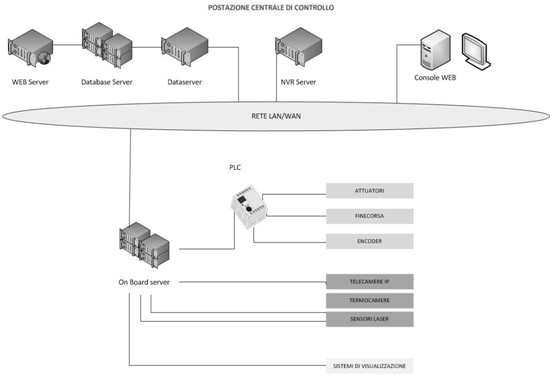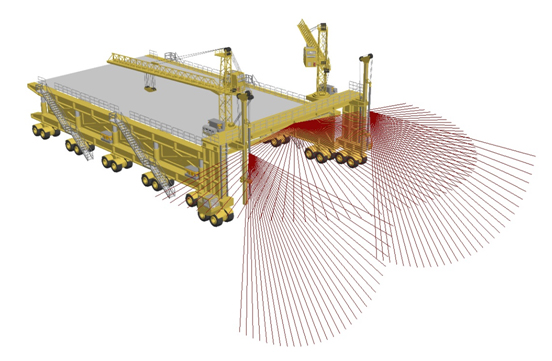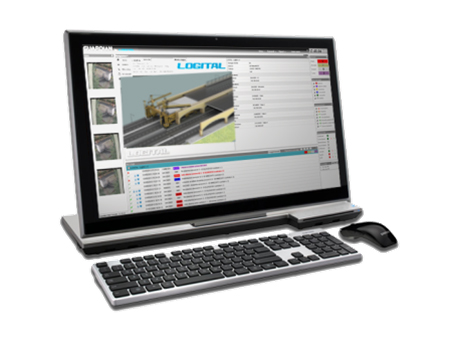
SAFETY AND AUTOMATION
The Safety and Automation system is responsible for the management of all on-board electronics. It also serves as a remote control and back-up for all the operating procedures and control features relative to its operations and safety.
The entire platform is based on SCADA centralization, which in turn is based on the proprietary module GUARDIAN. The latter uses the core software of electronic data collection and its corresponding implementation on the ground.
The module called OVERBUILD is fully server controlled in handling the other modules for the construction of road surface and all related structures. It is also equipped with integrated systems responsible for the management of active safety features, which are necessary to ensure safety of the operators and safety of the vehicles in transit against fire and intrusions or theft.

CONTROL FEATURES AND ANTI-COLLISION
The platform is equipped with a proprietary system called ACS (Anti Collision System). It serves to prevent, by means of advanced and machine-fed commands to the platform, any threat of collisions with any road surface or structures which have already been built.
The ACS shall achieve such protocol using a "carpet-like" laser placed at a specific programmable distance from platform, above and parallel to it. The laser shall use two 2D sensor with detection angle set at 90 °.

By means of real time processing of any intercepted radiation, this system shall check, using 25Hz frequency, that the pre-set safety distance between the road surface and the platform is observed and respected at all times. This shall be done in complete disregard of any road obstacles, whether caused by humans or by moving vehicles involved in the constructions.
The ACS system is capable of intereacting with the platform’s handling system, with the system for moving on the road, and with all the mobile systems (e.g. cranes) which are at risk of colliding with external obstacles, or which can engage in any circumtances of of potential risk in the event of accidental release of the load.
All the logic and the movements are managed through a network of PLC, which perform the task of managing the various movements safely and securely. This shall be done through servo interactions in real time from limit switches and linear encoders.
Real-time detection of position and movements are based on differential GPS detection techniques, which allow monitoring with centimeter accuracy.
SAFETY PROTOCOLS
The machine, by collecting data in the field, performs real time interpolation with information from other systems (such as thermal cameras). It can send signals or alerts in case of dangerous situations or events. It may also intervene directly on the movement of the platform in case the danger will pose hazard to people on board or to any object or structure directly at the path of the platform.
The machine includes areas off-limits to human presence. These areas become off-limits depending on the state of the machine, such as, for example, when the machines are in state of progress or state of platform movement.
The prohibited areas are monitored through two systems: The ACS system and the Radar system. Monitoring is realized by means of the latest generation of sensors capable of monitoring movement and presence of objects within radius of 600 meters.

A second thermal radar placed in the lower area (vehicle transit area) is capable of detecting:
1. the presence of pedestrians or animals on the roadway of the tunnel
2. the presence of stationary vehicles under the tunnel
VIDEO SYSTEM OR CCTV
On board the platform there is a sophisticated CCTV system, composed of 16 fixed cameras and 4 PTZ, which are capable of sending to the control center:
• 8 views of the sides
• 4 platform views (4 corners)
• 2 tunnel views
• 1 front view
• 1 rear view
• 4 megapixel swivel dome cameras
All fixed and PTZ cameras are linked to a network video recorder or NVR, where all video streams are captured and stored for further analysis and review. The on-board CCTV system plays a fundamental role, since it performs 3 important functions:
1. REMOTE MANAGEMENT: Direct supervision and control, in real time, may be undertaken remotely through the control center and the CCTV System. In particular, the CCTV allows the operator to select any camera view (single or multiple views) in order to efficiently control the platform in the performance of any specific tasks.
2. SECURITY: The CCTV system is equipped with image analysis powered by motion-detection algorithms that can detect movements or presence of objects within its scope or covered areas. It also essentially creates a system to prevent illegal intrusion or trespass and allows monitoring of personnel to ensure their safety and security at all times.
3. TRAFFIC CONTROL: Real time traffic control is possible using the CCTV systems’ 2 tunnel and 2 street camera views. Moreover, the system’s algorithms allow it to analyze the traffic data and automatically highlight critical situations including events where there are unusual heavy or stationary traffic or any road accidents.
Furthermore, the CCTV system, through the thermal camera and radar systems, is also capable of detecting, in real time, unusual heat or fire on the platform or along the roads and inside any tunnels.
VISUAL WARNING AND SAFETY SIGNAGES
The platform’s road and traffic / warning signages serve as a tool to inform and alert incoming and/or passing vehicles about road construction or any other road activities. Such timely signages conforms with the requirements of the law and traffic regulations.
In particular, the platform or machine is equipped with a radar detection system that allows it to verify the presence of any vehicle and its corresponding speed along the emergency lane (collision risk). The system has the capacity to detect vehicles from a distance of 500 meters from the plaftorm.
This system controls a number of optical and audio warning devices (high impact systems not high beam) which are configured to synchronize with the trajectory of the vehicle at risk of any impact.
In order to improve safety and minimize risk of vehicle collisions, the visual reporting or signage modules operate using 2 passive systems.
First, the on-board machine which consists of two rear caps equipped with hydraulic cylinders for absorption of energy arising from impact or kinetic energy. The same machine is capable of converting into heat 95% said impact or kinetic energy.
The second is developed by shaping or designing the emergency lanes, with new jersey type of plastics, 300 meters away from the machine with allowance for any possible changes in the location or distance
All related systems can be integrated further with the installation of sound bands placed along the emergency lanes between (a) the section which where the new jersey plastics were installed and (b) the section which is 500 meters away from where the machine was stationed.
CONTROL CENTER
The heart or center of the management of the platform / machine is represented by the remote control center. Using this, the project manager can manage, in real time, all the operating parameters and the progress of the project. The remote control center also allows interaction between and among the operators on board, using the point to point communication equipment. It will also assist the project manager make corrections or intervene with remedial or corrective procedures in case of danger or misuse by other users of the machine.

Through the CCTV system, the user or operator can see and control the various modules or controls of the machine, which are necessary in driving or moving the machine and the operation of the platform. The control center will incorporate all of the data from:
• PLC (handling and machine diagnostic)
• CCTV
• Radar thermal
• Laser guidance systems
• Collision Avoidance Systems
• Positioning Systems
The control center records and stores, among all other information, the operating parameters of the machines including all related images. This shall allow further analysis and review at any time thereafter.
A key role of the control center is monitoring the work-in-progress through real-time comparison of the design values stored in electronic format in the system and the construction values.
The Center will be able to handle, perform corrective or remedial actions (e.g. the sections of road surface) including the correction of heights and depths, by comparing all relevant data with other machines which the OVERBUILD is operating in parallel mode.
